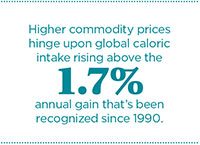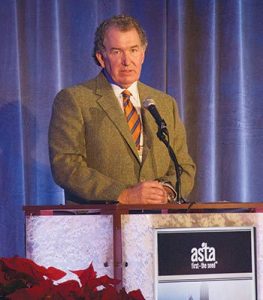Each year, the American Seed Trade Association hosts its corn, sorghum and soybean seed research conference. In case you missed it, here are a few of the highlights.
Nearly 3,000 seed industry professionals from around the world gathered in Chicago during the second week of December for the American Seed Trade Association’s 69th Corn & Sorghum Seed Research Conference and 44th Soybean Seed Research Conference and Seed Expo.
During the show, attendees conducted business meetings, the association focused on policy, and researchers spotlighted new developments and provided updates on their work.
“We had a lot of issues impacting the seed industry on this year’s program,” says Andy LaVigne, ASTA president and CEO. “There’s a great deal of conversation about intellectual property and how it impacts our companies’ ability to invest in developing new varieties and new technologies. Seed treatments and pollinators are a key issue for members, as well as the agricultural community.”
The key to moving all these issues forward is innovation. Innovation in the seed industry was a resounding theme during the show and something that Bill Whitacre, president and CEO of J.R. Simplot Company, spoke about during the opening general session.
“All that we know is that change is going to happen in the future,” Whitacre says, noting that it’s important to be a part of and support your industry. He adds that as businesses and as an industry, we should be organized around the opportunities available.
“The opportunity that we see at the Simplot Company all manifests itself in a word … the word is ‘innovation,’” Whitacre says. “I substitute the word ‘innovation’ sometimes with ‘intellectual curiosity,’ where we look at something and go ‘hmmm, there’s got to be a better way.’ If our employees and customers can have those types of discussions, it’s very freeing and effective for all of us.”
Whitacre explains that at Simplot, his team took on this grand experiment. “We took 25 percent of the incentive, or merit compensation, and put it into an innovation component for every employee in the company,” he says. “It’s allowed us to take an innovative company — a company that’s always been creative and created new things — and it’s allowed us to focus on innovation and reward innovation. It’s also allowed us to stop and ask ourselves what’s innovative about what we’re doing, or are we just perfecting the wheel. Frequently, it’s both, and that’s OK.”
Whitacre says that agriculture is at an intersection. “We’re between standard agricultural production and technology, and that intersection is where the world is going to have to play,” he says. “We’re going to have to play not just on our own terms, but we’re going to have to play on everybody else’s terms. We have opportunities.”
Innovation Needed
From Whitacre’s holistic perspective, he says the technology advancements that agriculture has to make are tremendous — from agronomics to genetics, and from plant breeding to sustainability and food processing. “The opportunity that we have with food processing is literally off the charts,” he says. When all these pieces are put together, Whitacre says, “simply stated: we have to do more with less.”
Dan Basse, an agricultural economist with AgResource Company, started his presentation around the notion of farmers needing to produce more for a growing global population while using fewer resources. However, he says that the outlook for agriculture, especially when it comes to commodity prices, isn’t so bright.
In fact, Basse says that corn prices won’t rise above $5 per bushel for the next several years, unless there is a severe weather event. During his presentation, he highlighted six key drivers that the seed industry needs to be aware of.
“The world’s biofuel industry is mature,” Basse says, noting that there are no new corn based ethanol plants under construction in the United States or the European Union. “Ethanol consumption has reached the blend wall.”
Basse also calls attention to the fact that outside of China’s record large demand for soybeans, the world lacks a bullish demand driver. “This is a much different landscape than the prior bull period from 2006 to 2013,” he says.

While supply and demand factors are always at play, Basse adds that currency must also be taken into consideration. “A rising U.S. dollar and falling energy prices argue against the broad commodity market in 2015,” he says. Crude oil, Basse expects, will bottom out in 2016 at about $40 to $45 per barrel.
Due to these factors listed above, Basse cautions that a readjustment period lies ahead for the world’s grain and oilseed farmers for the next three to five years with profits far below what was realized from 2005 to 2013. This means that “U.S. and world government programs become paramount for producers,” Basse says.
Between Basse’s depressed outlook for commodities and Whitacre’s intersection, it’s more important than ever to advocate on behalf of the seed industry and agriculture, and that’s exactly what ASTA members and staff are setting out to do, according to LaVigne and John Schoenecker, ASTA chairman.
“Advocacy is the theme that I’ve been promoting with our members,” Schoenecker says. “It’s something that we’ve been doing at ASTA for a number of years, but we are trying to step it up a bit and really develop our ‘A’ game.”
As part of that effort, ASTA unveiled results from new research that evaluated consumer perception and appreciation of seed and seed improvements, as well as a new communications initiative to help improve consumer confidence. “The agricultural industry recognizes the significance of seed innovation ,and that many of the things that improve our quality of life can be traced back to a seed,” LaVigne says. “But when we reach beyond the industry, we realize we have work to do in educating people about the value of seed and seed improvements.”
Schoenecker adds that advocacy is one of the reasons that this year’s ASTA Annual Convention will return to Washington, D.C., June 17-20. “We’ll have a day where we ‘Storm the Hill’ to advocate for the issues that are important to the industry,” he says.















